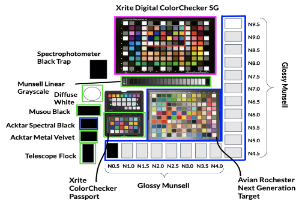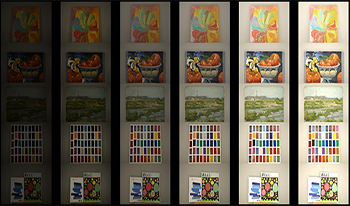
The capability for a camera to produce a color-accurate high dynamic range image is based upon its capture of luminance within a scene as well as the targets chosen to create the color transformation matrix. The wide-ranging luminance within a scene is an important part of cultural heritage documentation to appropriately capture an object's appearance. In addition, color accuracy is critical to documenting cultural heritage appropriately. This research compares prosumer and mobile phone cameras for cultural heritage documentation using single exposure and high dynamic range images. It focuses on the evaluation of color characterization process, color reproduction quality, and generation of the scene. This was done by using two types of prosumer cameras and two types of mobile phone cameras, at 800 lux with a wide range of color targets with various surface textures, matte, semigloss, and glossy. It was found that for creating color calibration matrices, a single exposure outperformed the one created from fusion of multiple exposure images. Additionally, including an extended achromatic scale along with the traditional Macbeth colors as part of the training data for the color calibration matrix may increase color accuracy for different cameras and the samples in the scene.

The purpose of this study is to accumulate colour appearance data under high dynamic luminance range. Two experiments were conducted based on different types of stimuli, colour patches and colour images. The colour patch experiment was conducted to match corresponding data between colors on a display and the real scene viewed under high dynamic range viewing conditions. Ten observers assessed 13 stimuli under 6 illuminance levels ranged from 15, 100, 1000, 3160, 10000 to 32000 lux. Observers adjusted the color patches on a display screen to match the color samples of the real scene against of a neutral background (The reflectivity was 35%). The visual results showed a clear trend, an increase of illuminance level raised vividness perception (both increases in lightness and colorfulness). However, CAM16-UCS did not give accurate prediction to the visual results, especially in the lightness direction. The model was then refined to achieve satisfactory performance and to truthfully reflect the visual phenomena. By modifying the lightness induction factor in calculating lightness according to adaptive luminance, the predictions of the model and the visual results had a good agreement in the direction of colour shift. The colour image experiment was carried out using 3 images assessed by 10 observers to test the CAM16-UCS on image generation. The results showed the modified model based on patches do not perform well and a further modification was made to come out a modified CAM16-UCS for images.

Color volumes in the new color spaces ICtCp and Jzazbz are used to characterize the performances of different types of displays. The viewing angle behavior of the emissive properties of one QLED TV and one OLED TVs are measured and compared. The influence of the top polarizer on the reflective properties of one LCD vehicle display is also measured and the color performances under various parasitic illumination are predicted.